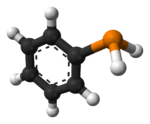- Phenylphosphine
-
Phenylphosphine 
 Other namesMonophenylphosphine
Other namesMonophenylphosphineIdentifiers CAS number 638-21-1 Properties Molecular formula C6H5PH2 Molar mass 110.09 g/mol Appearance Colorless liquid Density 1.001 g/cm³ Melting point ? °C
Boiling point 160 °C (433 K)
Hazards R-phrases R11, R17, R23/24/25, R36/37/38, R48/20, R62, R65, R67, R51/53 S-phrases S16, S26, S36/37/39, S45, S62  (verify) (what is:
(verify) (what is:  /
/ ?)
?)
Except where noted otherwise, data are given for materials in their standard state (at 25 °C, 100 kPa)Infobox references Phenylphosphine is a primary phosphine with the chemical formula C6H5PH2. It is the phosphorus analog of aniline. Like all other primary phosphines, phenylphosphine has an intense penetrating odor. Its chemistry is very similar to other primary phosphines: it is highly oxidizable, it can function as ligands in complexes, and it is highly nucleophilic.[1]
Synthesis
Phenylphosphine can be produced by reducing dichlorophenylphosphine with lithium aluminum hydride at the reflux temperature of ether.
- LiAlH4 + 2C6H5PCl2 → 2C6H5PH2 + Li+ + Al3+ + 4Cl-
This reaction must be performed under a nitrogen atmosphere as phenylphosphine can be oxidized by oxygen.[2]
Reactions
Bis(2-cyanoethylphenyl)phosphine, which is of interest as a synthetic intermediate, can be made from phenylphosphine by base-catalyzed allylic addition to acrylonitrile.
- C6H5PH2 + 2CH2=CHCN → C6H5P(CH2CH2CN)2
Bis(2-cyanoethylphenyl)phosphine is useful in synthesis as it can be used to prepare 1-phenyl-4-phosphorinanone. This is done by first refluxing the bis(2-cyanoethylphenyl)phosphine in toluene with potassium tert-butoxide followed by vigorous reflux with 6 N HCl. Phosphorinanones are very useful synthetic intermediates as they can be used to prepare alkenes, amines, indoles, and secondary and tertiary alcohols by reduction, Grignard, and Reformatsky reagents. [3]
Phenylphophine can also be used to prepare benzenephosphonous acid by oxidation with air.[2]
- C6H5PH2 + O2 → C6H5P(OH)2
Phenylphosphine can function as ligands in Ge, Sn, and Pb complexes. The phenylphosphine complexes of Ge, Sn, and Pb will from metal clusters. The phenylphosphine ligand will bridge two metal atoms.[4]
- 2(C6H5)2MCl + C6H5PH2 + 3(C2H5)3N →((C6H5)2M)2PC6H5
+ 3(C2H5)3N•HCl
Phenylphosphine also have uses in polymer synthesis. Using radical initiations or UV irradiation, polyaddition of phenylphosphine to 1,4-divinylbenzene or 1,4-diisopropenylbenzene will form phosphorus-containing polymers. Phosphorus-containing polymers have self-extinguishing properties. When mixed with flammable polymers such as polystyrene and polyethylene, the mixed polymer exhibit flame resistant properties.[5]
References
- ^ Svara, Jürgen; Weferling, Norbert ; Hofmann, Thomas "Phosphorus Compounds, Organic" in Ullmann's Encyclopedia of Industrial Chemistry. John Wiley & Sons, Inc, 2008. DOI: 10.1002/14356007
- ^ a b Freedman, Leon D.; Doak, G. O. (1952). "The Reduction of Benzenephosphonyl Dichloride". Journal of the American Chemical Society 74 (13): 3414–3415. doi:10.1021/ja01133a504.
- ^ Snider, Theodore E.; Morris, Don L.; Srivastava, K. C.; and Berlin, K. D. (1988), "1-Phenyl-4-Phosphorinanone", Org. Synth., http://www.orgsyn.org/orgsyn/orgsyn/prepContent.asp?prep=cv6p0932; Coll. Vol. 6: 932
- ^ Schumann, Herbert; Schwabe, Peter; Stelzer, Othmar (1969). "Organogermyl, stannyl und plumbylphosphine". Chemische Berichte 102 (9): 2900–2913. doi:10.1002/cber.19691020904.
- ^ Obata, Takatsugu; Kobayashi, Eiichi; Aoshima, Sadahito; Furukawa, Junji (1994). "Synthesis of new linear polymers containing phosphorus atom in the main chain by the radical polyaddition: Addition polymers of phenylphosphine with 1,4-divinylbenzene or 1,4-diisopropenylbenzene and their properties". Journal of Polymer Science Part A: Polymer Chemistry 32 (3): 475–483. doi:10.1002/pola.1994.080320309.
Categories:- Phosphines
Wikimedia Foundation. 2010.
